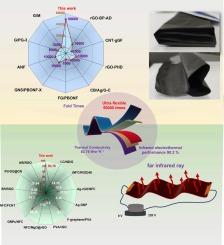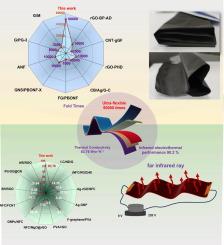基于多分子诱导取向和界面调节的石墨烯基超折叠电阻和高效电热薄膜的制备
IF 13.2
1区 工程技术
Q1 ENGINEERING, CHEMICAL
引用次数: 0
摘要
石墨烯(Gr)电热膜是一种复合聚合物导电膜,由于其独特的物理性能,作为一种新型材料备受关注。然而,目前报道的石墨烯电热膜柔韧性不足,制备成本相对较高。此外,热处理工艺显著影响这些薄膜的性能。本研究选择姜黄素(CU)和羧甲基纤维素(CMC)分别作为分散剂和粘合剂,协同诱导石墨烯与SiO2纳米颗粒的取向和界面调节,构建高柔性电热膜。CU含有羟基,分子间表现出较强的氢键相互作用,可以增强石墨烯浆料的界面相容性,减少石墨烯团聚。SiO2纳米颗粒可以通过氢键相互作用牢固地固定在石墨烯片表面,有效地防止聚集。CMC与Gr有多种键合模式,有利于薄膜扩散,显著提高柔韧性。在水解过程中,CMC释放Na+,进一步稳定石墨烯的分散。同时,采用创新的铺膜工艺-悬浮镀膜-浇铸法制备了大面积超柔性石墨烯电热薄膜(HF-Gr/CMC)。该工艺直接且易于实施,无需热处理,因此大大降低了生产成本,同时具有大规模制造的潜力。所制备的薄膜具有优异的耐久性,可以180度折叠50000次,同时保持稳定的性能,大大超过了报道的石墨烯基复合电热薄膜的折叠电阻值。薄膜还具有均匀的加热温度分布,热辐射效率达到90.2 %,热导率达到83.76 Wm−1 K−1。这些特性为石墨烯电热薄膜领域的持续增强和发展提供了可行的解决方案。本文章由计算机程序翻译,如有差异,请以英文原文为准。


Facile construction of graphene based ultra folding resistance and high-efficiency electric heating film by multi-molecules induced orientation and interface regulation
Graphene (Gr) electrothermal film is a composite polymer conductive film that has garnered significant attention as a novel material due to its unique physical properties. However, the flexibility of the currently reported graphene electrothermal films is insufficient, and their preparation costs are relatively high. Additionally, the heat treatment process significantly influences the performance of these films. In this study, curcumin (CU) and carboxymethyl cellulose (CMC) were selected as dispersant and binder respectively, which synergistically induced graphene orientation and interface regulation with SiO2 nanoparticles to construct highly flexible electrothermal film. CU contains hydroxyl groups and exhibits strong hydrogen bond interactions between molecules, which can enhance the interfacial compatibility of graphene paste and reduce graphene agglomeration. SiO2 nanoparticles can be firmly anchored to the surface of graphene sheets through hydrogen bond interactions, effectively preventing aggregation. CMC has various bonding modes with Gr, which can facilitate film diffusion and significantly improve flexibility. During hydrolysis, CMC releases Na+, further stabilizing the dispersion of graphene. Simultaneously, an innovative film-laying process-suspension coating and casting method was employed to prepare large-area ultra-flexible graphene electrothermal films (HF-Gr/CMC). This process is straightforward and easy to implement without heat treatment, thus considerably reducing production costs while enabling potential for large-scale manufacturing. The obtained film demonstrates remarkable durability, which can be folded 180 degrees for 50,000 cycles while maintaining stable performance, significantly exceeding the reported folding resistance values of graphene based composite electrothermal films. The film also exhibits uniform heating temperature distribution with thermal radiation efficiency reaching 90.2 %, alongside impressive thermal conductivity measured at 83.76 Wm−1 K−1. These attributes provide a viable solution for ongoing enhancement and development in the field of graphene electrothermal films.
求助全文
通过发布文献求助,成功后即可免费获取论文全文。
去求助
来源期刊

Chemical Engineering Journal
工程技术-工程:化工
CiteScore
21.70
自引率
9.30%
发文量
6781
审稿时长
2.4 months
期刊介绍:
The Chemical Engineering Journal is an international research journal that invites contributions of original and novel fundamental research. It aims to provide an international platform for presenting original fundamental research, interpretative reviews, and discussions on new developments in chemical engineering. The journal welcomes papers that describe novel theory and its practical application, as well as those that demonstrate the transfer of techniques from other disciplines. It also welcomes reports on carefully conducted experimental work that is soundly interpreted. The main focus of the journal is on original and rigorous research results that have broad significance. The Catalysis section within the Chemical Engineering Journal focuses specifically on Experimental and Theoretical studies in the fields of heterogeneous catalysis, molecular catalysis, and biocatalysis. These studies have industrial impact on various sectors such as chemicals, energy, materials, foods, healthcare, and environmental protection.
 求助内容:
求助内容: 应助结果提醒方式:
应助结果提醒方式:


